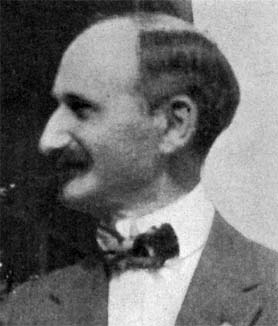
Ernest Julius Wilczynski
 المؤلف:
A Seidenberg
المؤلف:
A Seidenberg
 المصدر:
Biography in Dictionary of Scientific Biography
المصدر:
Biography in Dictionary of Scientific Biography
 الجزء والصفحة:
...
الجزء والصفحة:
...
 1-5-2017
1-5-2017
 663
663
Born: 13 November 1876 in Hamburg, Germany
Died: 14 September 1932 in Denver, Colorado, USA

Ernest Wilczynski parents were Max Wilczynski and Friederike Hurwitz. He attended school in Hamburg for two years. Then his family emigrated to the United States and settled in Chicago. Wilczynski attended schools in Chicago, but rather than take his university education in the United States he returned to Germany to study at the university of Berlin.
Wilczynski was taught at Berlin by some outstanding mathematicians including Fuchs, Hensel, Planck, Pringsheim, Schlesinger and Schwarz. He received his doctorate from the University of Berlin in 1897 and returned to the United States. He did not find a university post and decided to take a temporary post in the Office of the Nautical Almanac in Washington D.C. However, in 1898, he was offered a position as instructor at the University of California.
In 1902 Wilczynski was promoted to assistant professor at Berkeley, then in 1906 to associate professor. During the years from 1903 to 1905 Wilczynski worked in Europe as associate of the Carnegie Institution. During his time in Verona, Italy he met his future wife and they were married in 1906. Wilczynski moved to the University of Illinois in 1907, then in 1910 he was appointed to Chicago filling a vacancy caused by the death of Maschke in 1908. Promotion to a full professor came at Chicago in 1914 but by 1919 his health began to fail. He continued to teach and carry out his other duties under increasing difficulties. Lane writes in [3]:-
... in the midst of a lecture [in 1923] he finally realised that he could go no further and, with a simple statement to that effect, walked from his classroom never to return, leaving his students amazed by the classic self-restraint with which he accepted his tragic fate. It is characteristic of the man, however, that during the long illness which followed he never lost his interest in geometry and never gave up hope and the belief that he would some day be able to return to his academic duties.
Wilczynski began his research career as a mathematical astronomer. This interest lasted until he was appointed to Berkeley. By that time he had published over a dozen papers in astronomy, but his interests moved towards differential equations which arose in his study of the dynamics of astronomical objects. From there his interests became pure mathematical interests in differential equations. However, Wilczynski's main work was in projective differential geometry and ruler surfaces. He extended Halphen's work, devised new methods and extended the theory of curves to surfaces. Lane [3] writes:-
It has often been stated that Wilczynski was the founder, or inventor, of projective differential geometry. This is not quite precise, for Halphen in the latter part of the nineteenth century was the first ever consciously to undertake and carry to fruition a systematic projective differential investigation. He was primarily interested in curves in the plane and in ordinary space. But Wilczynski was the first ever to appreciate, demonstrate and exploit the utility of completely integrable systems of linear homogeneous differential equations for projective differential geometry.
Wilczynski received many honours for his outstanding research contributions. He was Colloquium lecturer for the American Mathematical Society in New Haven in 1906 together with Max Mason and Eliakim Moore. In addition he served as vice-president of the American Mathematical Society and as a council member of the Mathematical Association of America. Among the prizes which he won was one awarded by the Royal Belgium Academy of Sciences in 1909. He was elected to the National Academy of Sciences in 1919, the year illness began to affect him.
It is not only as a research mathematician that Wilczynski excelled. He was a talented teacher bringing clarity through his carefully prepared lectures and extremely talented in mathematical exposition whether it was in English or German. He was almost equally at home with French or Italian. He is described by Lane [3] as:-
... gentle, his manner mild. He was unselfish and habitually thoughtful to others.
- A Seidenberg, Biography in Dictionary of Scientific Biography (New York 1970-1990).
http://www.encyclopedia.com/doc/1G2-2830904654.html
Articles:
- G A Bliss, Ernest Julius Wilczynski, Science 76 (1932), 316-317.
- E P Lane, Ernest Julius Wilczynski, Amer. Math. Monthly 39 (1932), 567-569.
- E P Lane, Ernest Julius Wilczynski - In Memoriam, Bull. Amer. Math. Soc. 39 (1933), 7-14.
 الاكثر قراءة في 1875to1879
الاكثر قراءة في 1875to1879
 اخر الاخبار
اخر الاخبار
اخبار العتبة العباسية المقدسة


